Strategic Asset Management Report: BP Case Study and Plan Development
VerifiedAdded on 2022/11/18
|23
|4024
|228
Report
AI Summary
This report focuses on strategic asset management, using the BP Deepwater Horizon disaster as a key case study. It begins with an introduction highlighting the importance of strategic asset management and its impact on asset lifecycles, especially in the context of potential disasters. The report then defines and explores the core concepts of strategic asset management, including both tangible and intangible assets, and illustrates the asset management excellence pyramid and total life cycle asset management. A critical analysis of the Deepwater Horizon incident is presented, examining the causes of the disaster and its consequences on BP's financial performance, brand image, and environmental impact. Finally, the report proposes a strategic asset management plan, including a risk management plan with a risk register and treatment plan, and an operations plan designed to mitigate risks and improve asset management practices. The plan emphasizes proactive measures and the integration of safety standards to ensure the long-term success of asset management strategies.
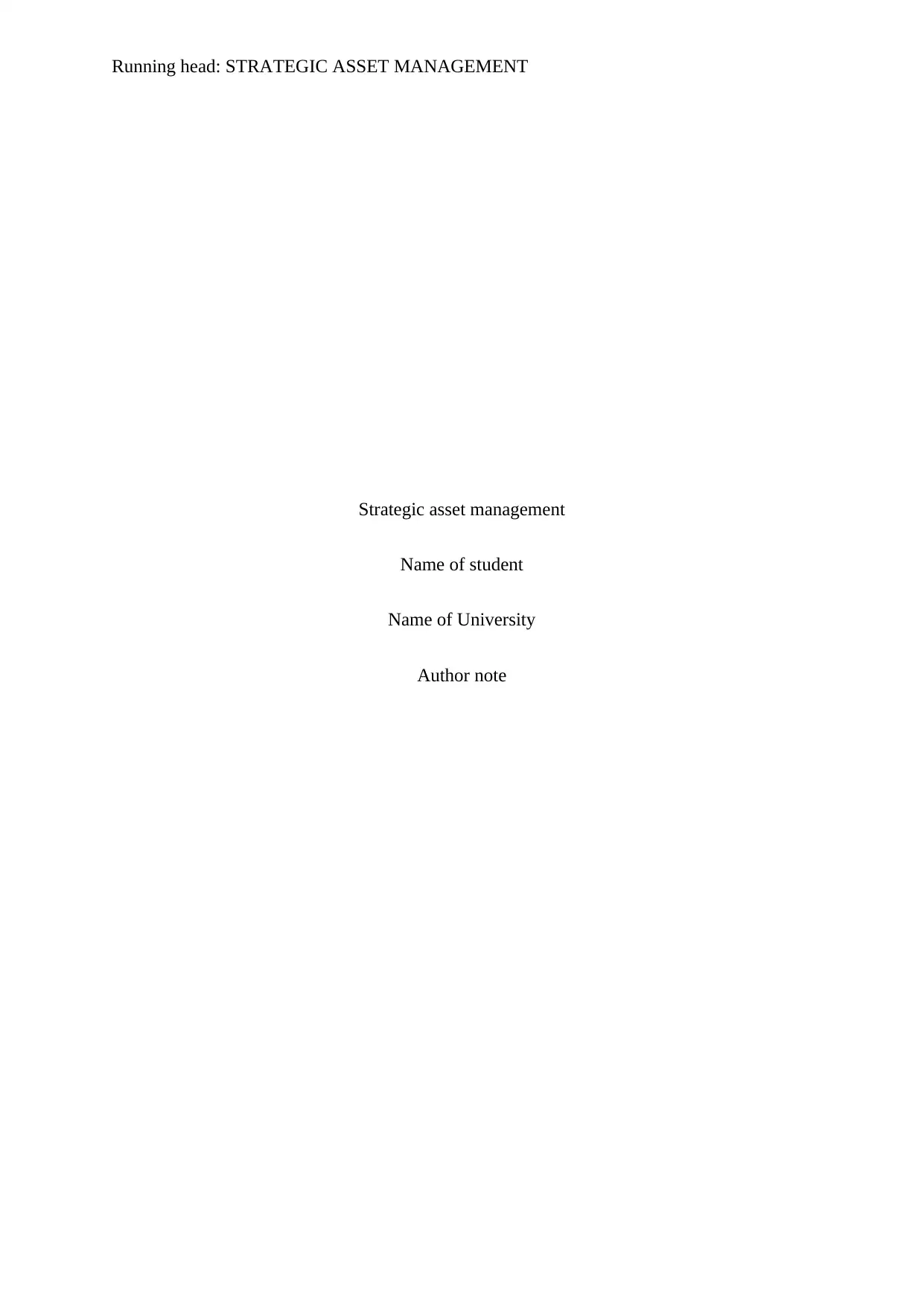
Running head: STRATEGIC ASSET MANAGEMENT
Strategic asset management
Name of student
Name of University
Author note
Strategic asset management
Name of student
Name of University
Author note
Paraphrase This Document
Need a fresh take? Get an instant paraphrase of this document with our AI Paraphraser
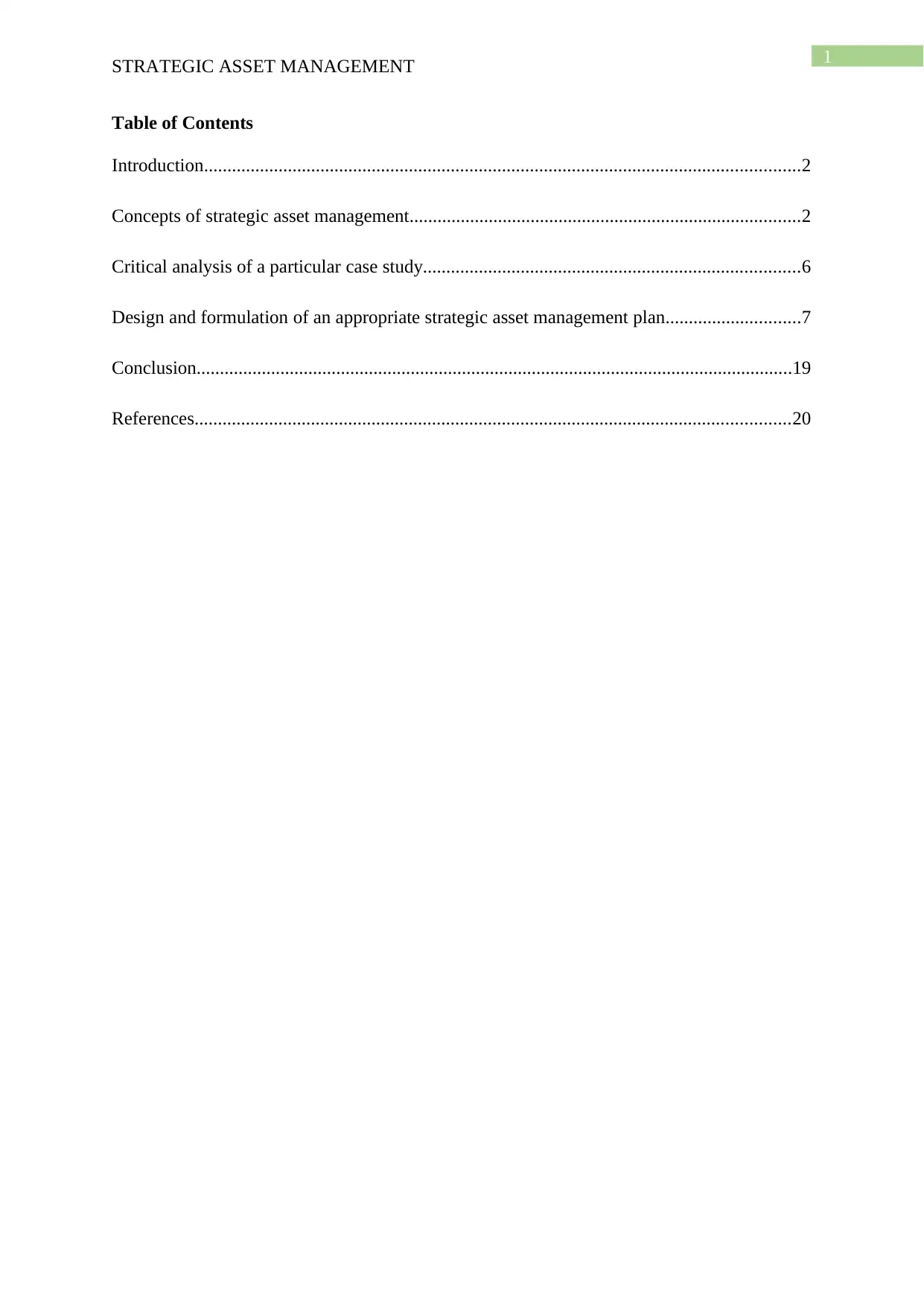
1
STRATEGIC ASSET MANAGEMENT
Table of Contents
Introduction................................................................................................................................2
Concepts of strategic asset management....................................................................................2
Critical analysis of a particular case study.................................................................................6
Design and formulation of an appropriate strategic asset management plan.............................7
Conclusion................................................................................................................................19
References................................................................................................................................20
STRATEGIC ASSET MANAGEMENT
Table of Contents
Introduction................................................................................................................................2
Concepts of strategic asset management....................................................................................2
Critical analysis of a particular case study.................................................................................6
Design and formulation of an appropriate strategic asset management plan.............................7
Conclusion................................................................................................................................19
References................................................................................................................................20
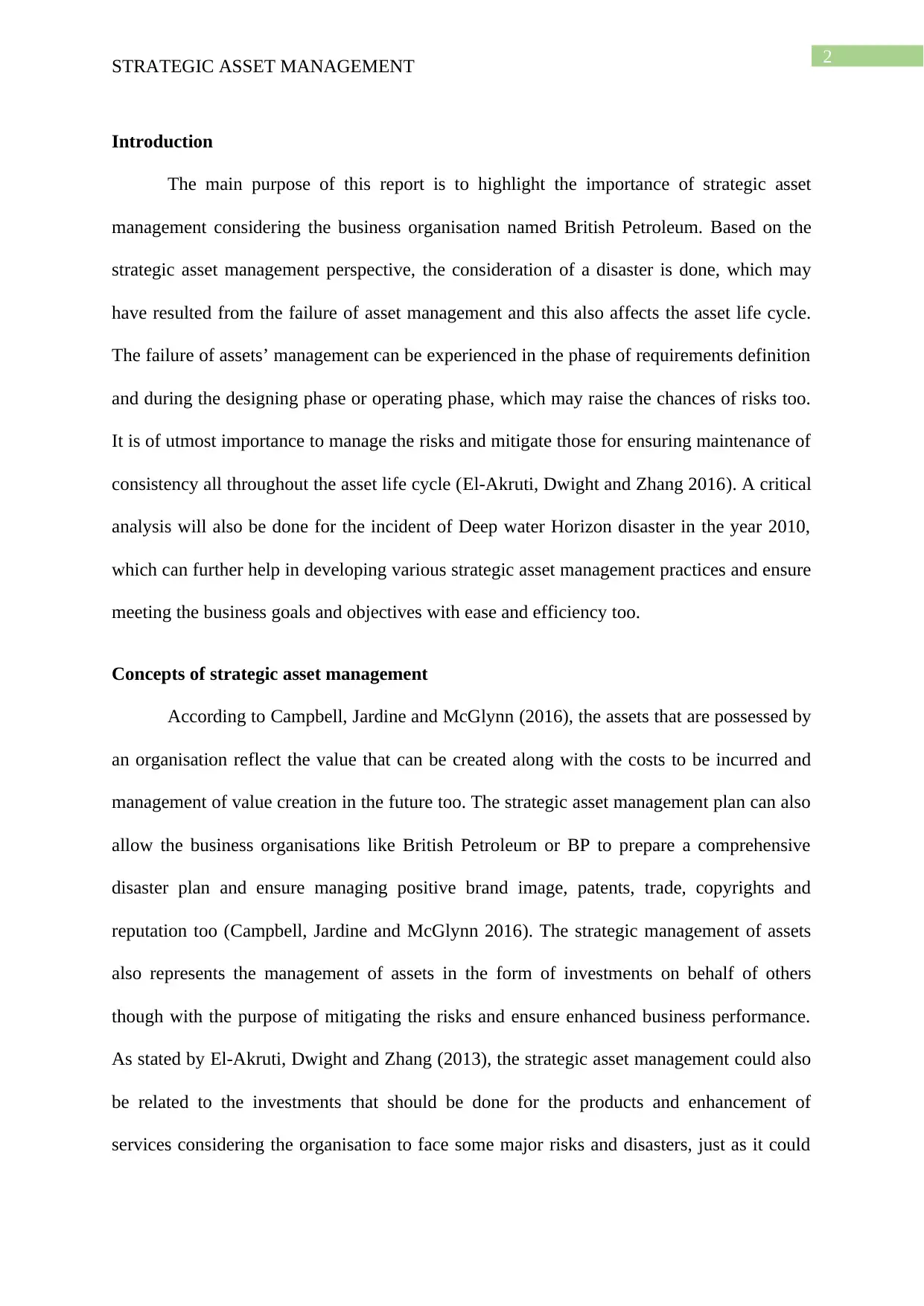
2
STRATEGIC ASSET MANAGEMENT
Introduction
The main purpose of this report is to highlight the importance of strategic asset
management considering the business organisation named British Petroleum. Based on the
strategic asset management perspective, the consideration of a disaster is done, which may
have resulted from the failure of asset management and this also affects the asset life cycle.
The failure of assets’ management can be experienced in the phase of requirements definition
and during the designing phase or operating phase, which may raise the chances of risks too.
It is of utmost importance to manage the risks and mitigate those for ensuring maintenance of
consistency all throughout the asset life cycle (El-Akruti, Dwight and Zhang 2016). A critical
analysis will also be done for the incident of Deep water Horizon disaster in the year 2010,
which can further help in developing various strategic asset management practices and ensure
meeting the business goals and objectives with ease and efficiency too.
Concepts of strategic asset management
According to Campbell, Jardine and McGlynn (2016), the assets that are possessed by
an organisation reflect the value that can be created along with the costs to be incurred and
management of value creation in the future too. The strategic asset management plan can also
allow the business organisations like British Petroleum or BP to prepare a comprehensive
disaster plan and ensure managing positive brand image, patents, trade, copyrights and
reputation too (Campbell, Jardine and McGlynn 2016). The strategic management of assets
also represents the management of assets in the form of investments on behalf of others
though with the purpose of mitigating the risks and ensure enhanced business performance.
As stated by El-Akruti, Dwight and Zhang (2013), the strategic asset management could also
be related to the investments that should be done for the products and enhancement of
services considering the organisation to face some major risks and disasters, just as it could
STRATEGIC ASSET MANAGEMENT
Introduction
The main purpose of this report is to highlight the importance of strategic asset
management considering the business organisation named British Petroleum. Based on the
strategic asset management perspective, the consideration of a disaster is done, which may
have resulted from the failure of asset management and this also affects the asset life cycle.
The failure of assets’ management can be experienced in the phase of requirements definition
and during the designing phase or operating phase, which may raise the chances of risks too.
It is of utmost importance to manage the risks and mitigate those for ensuring maintenance of
consistency all throughout the asset life cycle (El-Akruti, Dwight and Zhang 2016). A critical
analysis will also be done for the incident of Deep water Horizon disaster in the year 2010,
which can further help in developing various strategic asset management practices and ensure
meeting the business goals and objectives with ease and efficiency too.
Concepts of strategic asset management
According to Campbell, Jardine and McGlynn (2016), the assets that are possessed by
an organisation reflect the value that can be created along with the costs to be incurred and
management of value creation in the future too. The strategic asset management plan can also
allow the business organisations like British Petroleum or BP to prepare a comprehensive
disaster plan and ensure managing positive brand image, patents, trade, copyrights and
reputation too (Campbell, Jardine and McGlynn 2016). The strategic management of assets
also represents the management of assets in the form of investments on behalf of others
though with the purpose of mitigating the risks and ensure enhanced business performance.
As stated by El-Akruti, Dwight and Zhang (2013), the strategic asset management could also
be related to the investments that should be done for the products and enhancement of
services considering the organisation to face some major risks and disasters, just as it could
⊘ This is a preview!⊘
Do you want full access?
Subscribe today to unlock all pages.

Trusted by 1+ million students worldwide
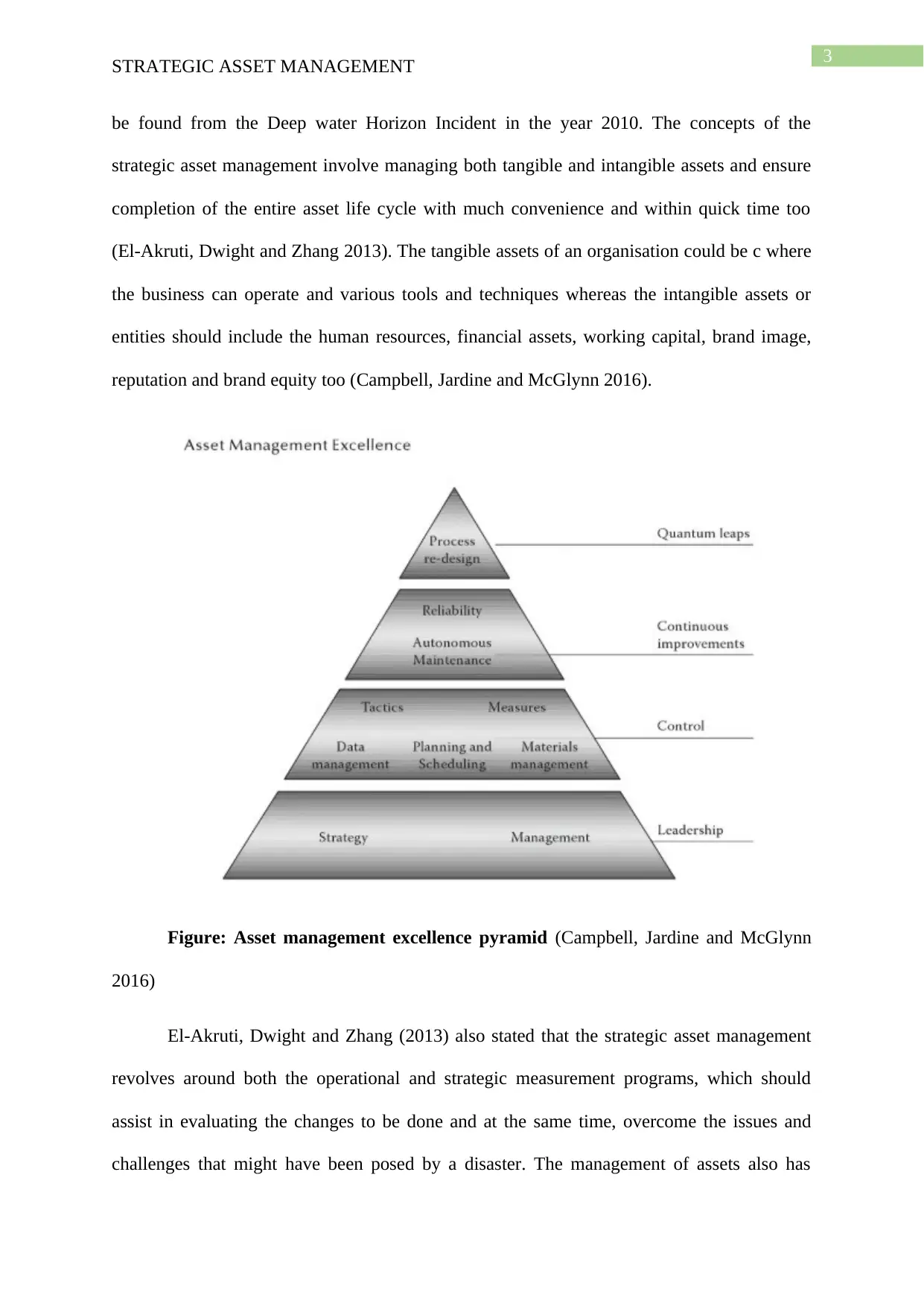
3
STRATEGIC ASSET MANAGEMENT
be found from the Deep water Horizon Incident in the year 2010. The concepts of the
strategic asset management involve managing both tangible and intangible assets and ensure
completion of the entire asset life cycle with much convenience and within quick time too
(El-Akruti, Dwight and Zhang 2013). The tangible assets of an organisation could be c where
the business can operate and various tools and techniques whereas the intangible assets or
entities should include the human resources, financial assets, working capital, brand image,
reputation and brand equity too (Campbell, Jardine and McGlynn 2016).
Figure: Asset management excellence pyramid (Campbell, Jardine and McGlynn
2016)
El-Akruti, Dwight and Zhang (2013) also stated that the strategic asset management
revolves around both the operational and strategic measurement programs, which should
assist in evaluating the changes to be done and at the same time, overcome the issues and
challenges that might have been posed by a disaster. The management of assets also has
STRATEGIC ASSET MANAGEMENT
be found from the Deep water Horizon Incident in the year 2010. The concepts of the
strategic asset management involve managing both tangible and intangible assets and ensure
completion of the entire asset life cycle with much convenience and within quick time too
(El-Akruti, Dwight and Zhang 2013). The tangible assets of an organisation could be c where
the business can operate and various tools and techniques whereas the intangible assets or
entities should include the human resources, financial assets, working capital, brand image,
reputation and brand equity too (Campbell, Jardine and McGlynn 2016).
Figure: Asset management excellence pyramid (Campbell, Jardine and McGlynn
2016)
El-Akruti, Dwight and Zhang (2013) also stated that the strategic asset management
revolves around both the operational and strategic measurement programs, which should
assist in evaluating the changes to be done and at the same time, overcome the issues and
challenges that might have been posed by a disaster. The management of assets also has
Paraphrase This Document
Need a fresh take? Get an instant paraphrase of this document with our AI Paraphraser
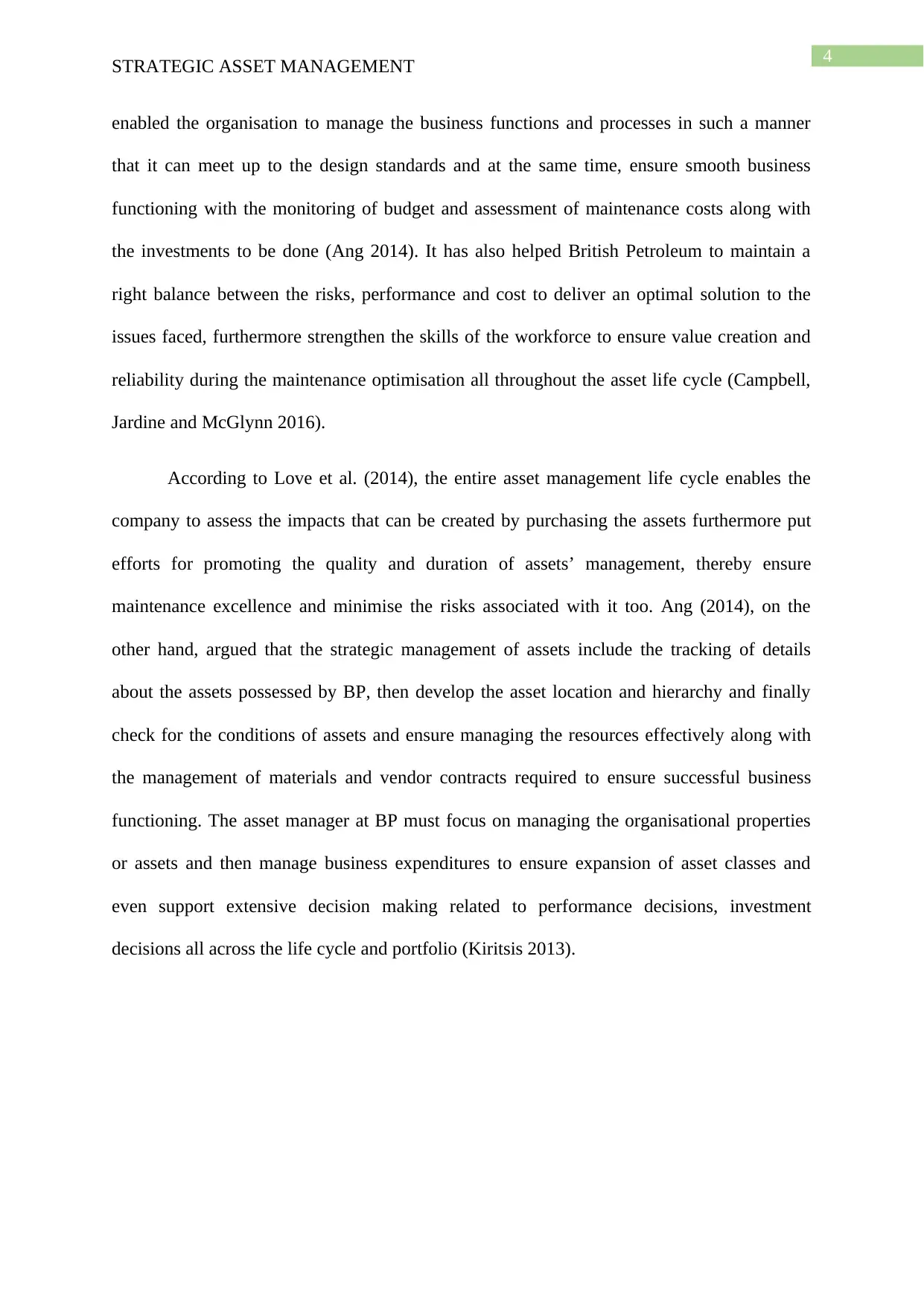
4
STRATEGIC ASSET MANAGEMENT
enabled the organisation to manage the business functions and processes in such a manner
that it can meet up to the design standards and at the same time, ensure smooth business
functioning with the monitoring of budget and assessment of maintenance costs along with
the investments to be done (Ang 2014). It has also helped British Petroleum to maintain a
right balance between the risks, performance and cost to deliver an optimal solution to the
issues faced, furthermore strengthen the skills of the workforce to ensure value creation and
reliability during the maintenance optimisation all throughout the asset life cycle (Campbell,
Jardine and McGlynn 2016).
According to Love et al. (2014), the entire asset management life cycle enables the
company to assess the impacts that can be created by purchasing the assets furthermore put
efforts for promoting the quality and duration of assets’ management, thereby ensure
maintenance excellence and minimise the risks associated with it too. Ang (2014), on the
other hand, argued that the strategic management of assets include the tracking of details
about the assets possessed by BP, then develop the asset location and hierarchy and finally
check for the conditions of assets and ensure managing the resources effectively along with
the management of materials and vendor contracts required to ensure successful business
functioning. The asset manager at BP must focus on managing the organisational properties
or assets and then manage business expenditures to ensure expansion of asset classes and
even support extensive decision making related to performance decisions, investment
decisions all across the life cycle and portfolio (Kiritsis 2013).
STRATEGIC ASSET MANAGEMENT
enabled the organisation to manage the business functions and processes in such a manner
that it can meet up to the design standards and at the same time, ensure smooth business
functioning with the monitoring of budget and assessment of maintenance costs along with
the investments to be done (Ang 2014). It has also helped British Petroleum to maintain a
right balance between the risks, performance and cost to deliver an optimal solution to the
issues faced, furthermore strengthen the skills of the workforce to ensure value creation and
reliability during the maintenance optimisation all throughout the asset life cycle (Campbell,
Jardine and McGlynn 2016).
According to Love et al. (2014), the entire asset management life cycle enables the
company to assess the impacts that can be created by purchasing the assets furthermore put
efforts for promoting the quality and duration of assets’ management, thereby ensure
maintenance excellence and minimise the risks associated with it too. Ang (2014), on the
other hand, argued that the strategic management of assets include the tracking of details
about the assets possessed by BP, then develop the asset location and hierarchy and finally
check for the conditions of assets and ensure managing the resources effectively along with
the management of materials and vendor contracts required to ensure successful business
functioning. The asset manager at BP must focus on managing the organisational properties
or assets and then manage business expenditures to ensure expansion of asset classes and
even support extensive decision making related to performance decisions, investment
decisions all across the life cycle and portfolio (Kiritsis 2013).
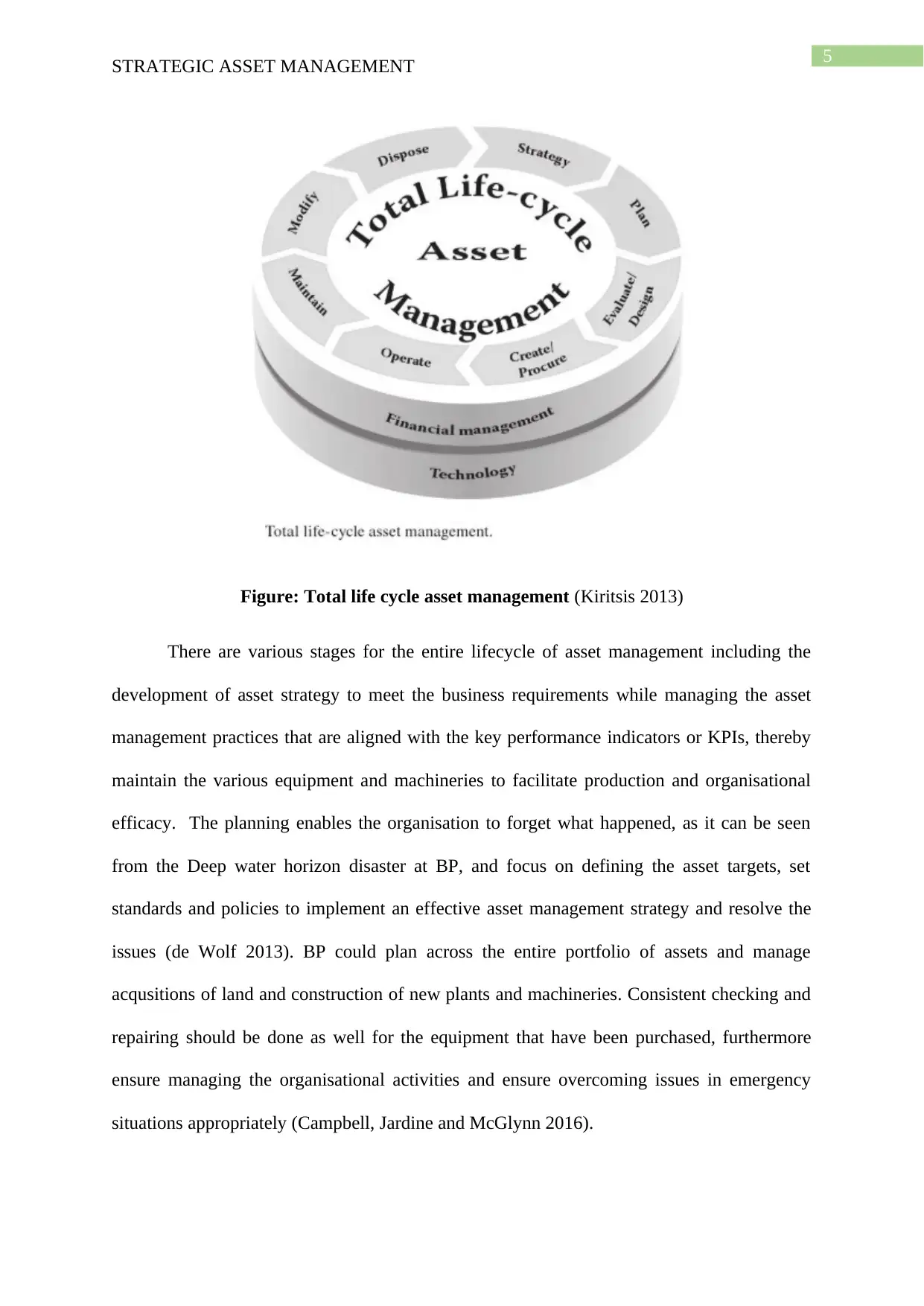
5
STRATEGIC ASSET MANAGEMENT
Figure: Total life cycle asset management (Kiritsis 2013)
There are various stages for the entire lifecycle of asset management including the
development of asset strategy to meet the business requirements while managing the asset
management practices that are aligned with the key performance indicators or KPIs, thereby
maintain the various equipment and machineries to facilitate production and organisational
efficacy. The planning enables the organisation to forget what happened, as it can be seen
from the Deep water horizon disaster at BP, and focus on defining the asset targets, set
standards and policies to implement an effective asset management strategy and resolve the
issues (de Wolf 2013). BP could plan across the entire portfolio of assets and manage
acqusitions of land and construction of new plants and machineries. Consistent checking and
repairing should be done as well for the equipment that have been purchased, furthermore
ensure managing the organisational activities and ensure overcoming issues in emergency
situations appropriately (Campbell, Jardine and McGlynn 2016).
STRATEGIC ASSET MANAGEMENT
Figure: Total life cycle asset management (Kiritsis 2013)
There are various stages for the entire lifecycle of asset management including the
development of asset strategy to meet the business requirements while managing the asset
management practices that are aligned with the key performance indicators or KPIs, thereby
maintain the various equipment and machineries to facilitate production and organisational
efficacy. The planning enables the organisation to forget what happened, as it can be seen
from the Deep water horizon disaster at BP, and focus on defining the asset targets, set
standards and policies to implement an effective asset management strategy and resolve the
issues (de Wolf 2013). BP could plan across the entire portfolio of assets and manage
acqusitions of land and construction of new plants and machineries. Consistent checking and
repairing should be done as well for the equipment that have been purchased, furthermore
ensure managing the organisational activities and ensure overcoming issues in emergency
situations appropriately (Campbell, Jardine and McGlynn 2016).
⊘ This is a preview!⊘
Do you want full access?
Subscribe today to unlock all pages.

Trusted by 1+ million students worldwide
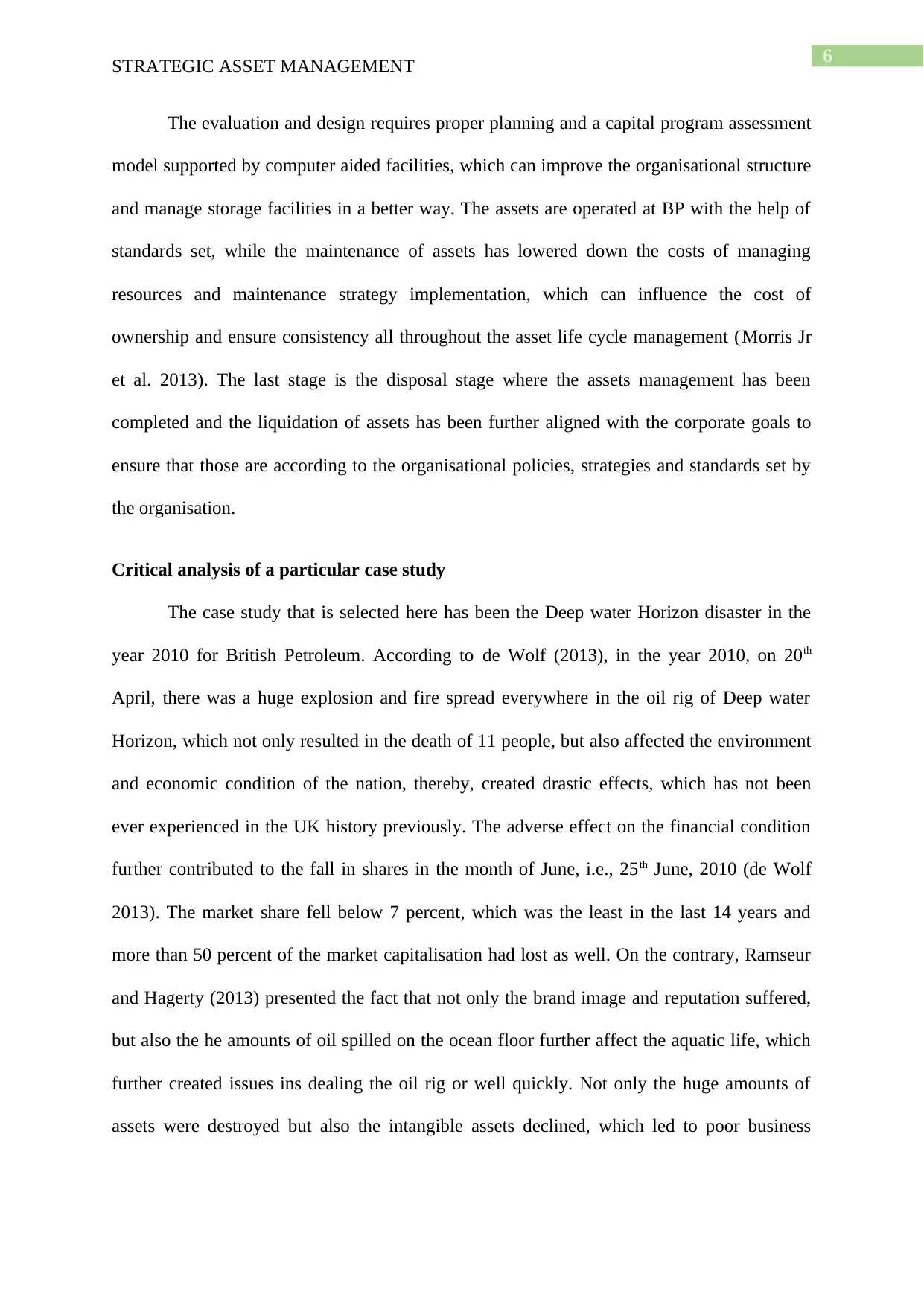
6
STRATEGIC ASSET MANAGEMENT
The evaluation and design requires proper planning and a capital program assessment
model supported by computer aided facilities, which can improve the organisational structure
and manage storage facilities in a better way. The assets are operated at BP with the help of
standards set, while the maintenance of assets has lowered down the costs of managing
resources and maintenance strategy implementation, which can influence the cost of
ownership and ensure consistency all throughout the asset life cycle management (Morris Jr
et al. 2013). The last stage is the disposal stage where the assets management has been
completed and the liquidation of assets has been further aligned with the corporate goals to
ensure that those are according to the organisational policies, strategies and standards set by
the organisation.
Critical analysis of a particular case study
The case study that is selected here has been the Deep water Horizon disaster in the
year 2010 for British Petroleum. According to de Wolf (2013), in the year 2010, on 20th
April, there was a huge explosion and fire spread everywhere in the oil rig of Deep water
Horizon, which not only resulted in the death of 11 people, but also affected the environment
and economic condition of the nation, thereby, created drastic effects, which has not been
ever experienced in the UK history previously. The adverse effect on the financial condition
further contributed to the fall in shares in the month of June, i.e., 25th June, 2010 (de Wolf
2013). The market share fell below 7 percent, which was the least in the last 14 years and
more than 50 percent of the market capitalisation had lost as well. On the contrary, Ramseur
and Hagerty (2013) presented the fact that not only the brand image and reputation suffered,
but also the he amounts of oil spilled on the ocean floor further affect the aquatic life, which
further created issues ins dealing the oil rig or well quickly. Not only the huge amounts of
assets were destroyed but also the intangible assets declined, which led to poor business
STRATEGIC ASSET MANAGEMENT
The evaluation and design requires proper planning and a capital program assessment
model supported by computer aided facilities, which can improve the organisational structure
and manage storage facilities in a better way. The assets are operated at BP with the help of
standards set, while the maintenance of assets has lowered down the costs of managing
resources and maintenance strategy implementation, which can influence the cost of
ownership and ensure consistency all throughout the asset life cycle management (Morris Jr
et al. 2013). The last stage is the disposal stage where the assets management has been
completed and the liquidation of assets has been further aligned with the corporate goals to
ensure that those are according to the organisational policies, strategies and standards set by
the organisation.
Critical analysis of a particular case study
The case study that is selected here has been the Deep water Horizon disaster in the
year 2010 for British Petroleum. According to de Wolf (2013), in the year 2010, on 20th
April, there was a huge explosion and fire spread everywhere in the oil rig of Deep water
Horizon, which not only resulted in the death of 11 people, but also affected the environment
and economic condition of the nation, thereby, created drastic effects, which has not been
ever experienced in the UK history previously. The adverse effect on the financial condition
further contributed to the fall in shares in the month of June, i.e., 25th June, 2010 (de Wolf
2013). The market share fell below 7 percent, which was the least in the last 14 years and
more than 50 percent of the market capitalisation had lost as well. On the contrary, Ramseur
and Hagerty (2013) presented the fact that not only the brand image and reputation suffered,
but also the he amounts of oil spilled on the ocean floor further affect the aquatic life, which
further created issues ins dealing the oil rig or well quickly. Not only the huge amounts of
assets were destroyed but also the intangible assets declined, which led to poor business
Paraphrase This Document
Need a fresh take? Get an instant paraphrase of this document with our AI Paraphraser
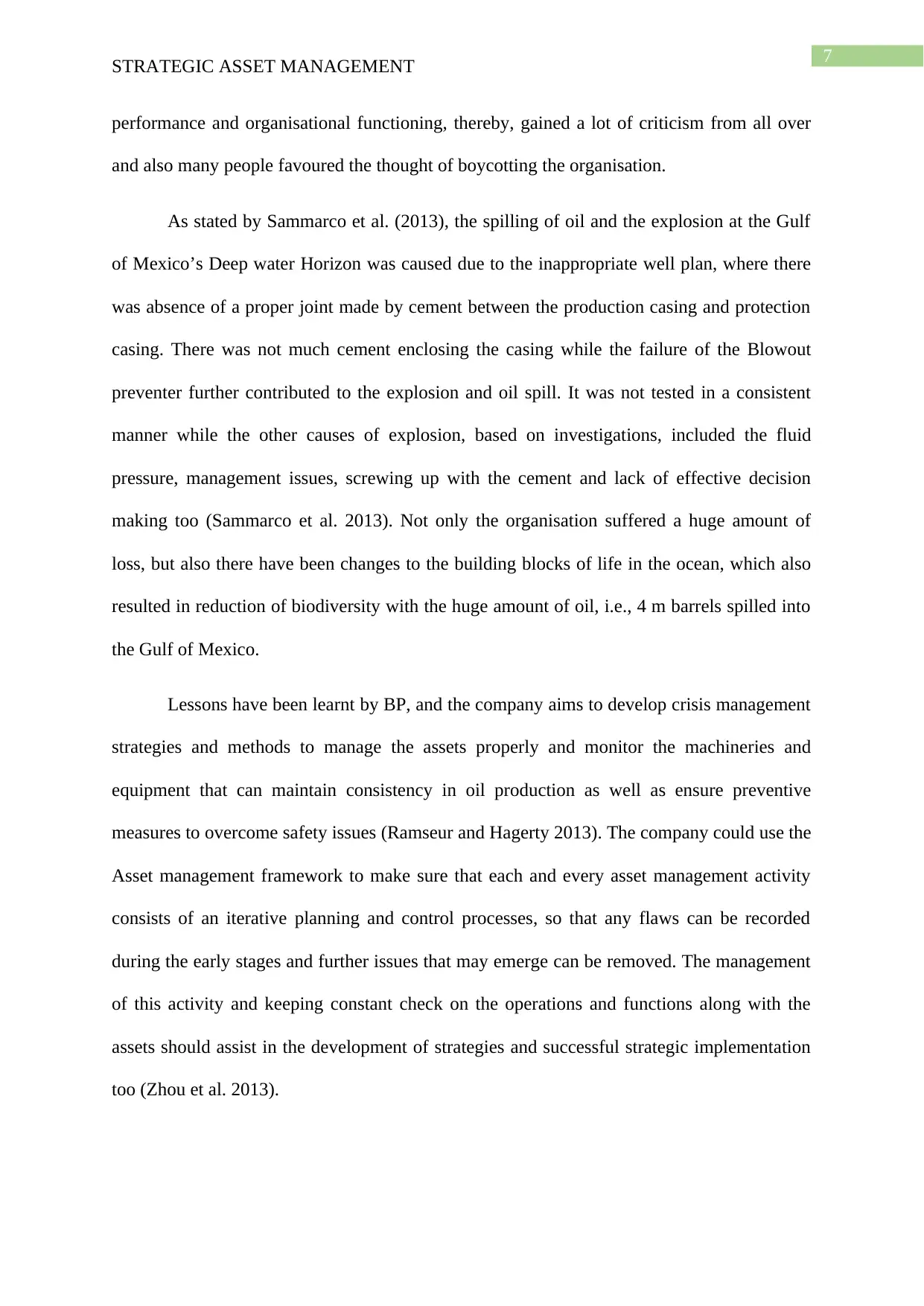
7
STRATEGIC ASSET MANAGEMENT
performance and organisational functioning, thereby, gained a lot of criticism from all over
and also many people favoured the thought of boycotting the organisation.
As stated by Sammarco et al. (2013), the spilling of oil and the explosion at the Gulf
of Mexico’s Deep water Horizon was caused due to the inappropriate well plan, where there
was absence of a proper joint made by cement between the production casing and protection
casing. There was not much cement enclosing the casing while the failure of the Blowout
preventer further contributed to the explosion and oil spill. It was not tested in a consistent
manner while the other causes of explosion, based on investigations, included the fluid
pressure, management issues, screwing up with the cement and lack of effective decision
making too (Sammarco et al. 2013). Not only the organisation suffered a huge amount of
loss, but also there have been changes to the building blocks of life in the ocean, which also
resulted in reduction of biodiversity with the huge amount of oil, i.e., 4 m barrels spilled into
the Gulf of Mexico.
Lessons have been learnt by BP, and the company aims to develop crisis management
strategies and methods to manage the assets properly and monitor the machineries and
equipment that can maintain consistency in oil production as well as ensure preventive
measures to overcome safety issues (Ramseur and Hagerty 2013). The company could use the
Asset management framework to make sure that each and every asset management activity
consists of an iterative planning and control processes, so that any flaws can be recorded
during the early stages and further issues that may emerge can be removed. The management
of this activity and keeping constant check on the operations and functions along with the
assets should assist in the development of strategies and successful strategic implementation
too (Zhou et al. 2013).
STRATEGIC ASSET MANAGEMENT
performance and organisational functioning, thereby, gained a lot of criticism from all over
and also many people favoured the thought of boycotting the organisation.
As stated by Sammarco et al. (2013), the spilling of oil and the explosion at the Gulf
of Mexico’s Deep water Horizon was caused due to the inappropriate well plan, where there
was absence of a proper joint made by cement between the production casing and protection
casing. There was not much cement enclosing the casing while the failure of the Blowout
preventer further contributed to the explosion and oil spill. It was not tested in a consistent
manner while the other causes of explosion, based on investigations, included the fluid
pressure, management issues, screwing up with the cement and lack of effective decision
making too (Sammarco et al. 2013). Not only the organisation suffered a huge amount of
loss, but also there have been changes to the building blocks of life in the ocean, which also
resulted in reduction of biodiversity with the huge amount of oil, i.e., 4 m barrels spilled into
the Gulf of Mexico.
Lessons have been learnt by BP, and the company aims to develop crisis management
strategies and methods to manage the assets properly and monitor the machineries and
equipment that can maintain consistency in oil production as well as ensure preventive
measures to overcome safety issues (Ramseur and Hagerty 2013). The company could use the
Asset management framework to make sure that each and every asset management activity
consists of an iterative planning and control processes, so that any flaws can be recorded
during the early stages and further issues that may emerge can be removed. The management
of this activity and keeping constant check on the operations and functions along with the
assets should assist in the development of strategies and successful strategic implementation
too (Zhou et al. 2013).
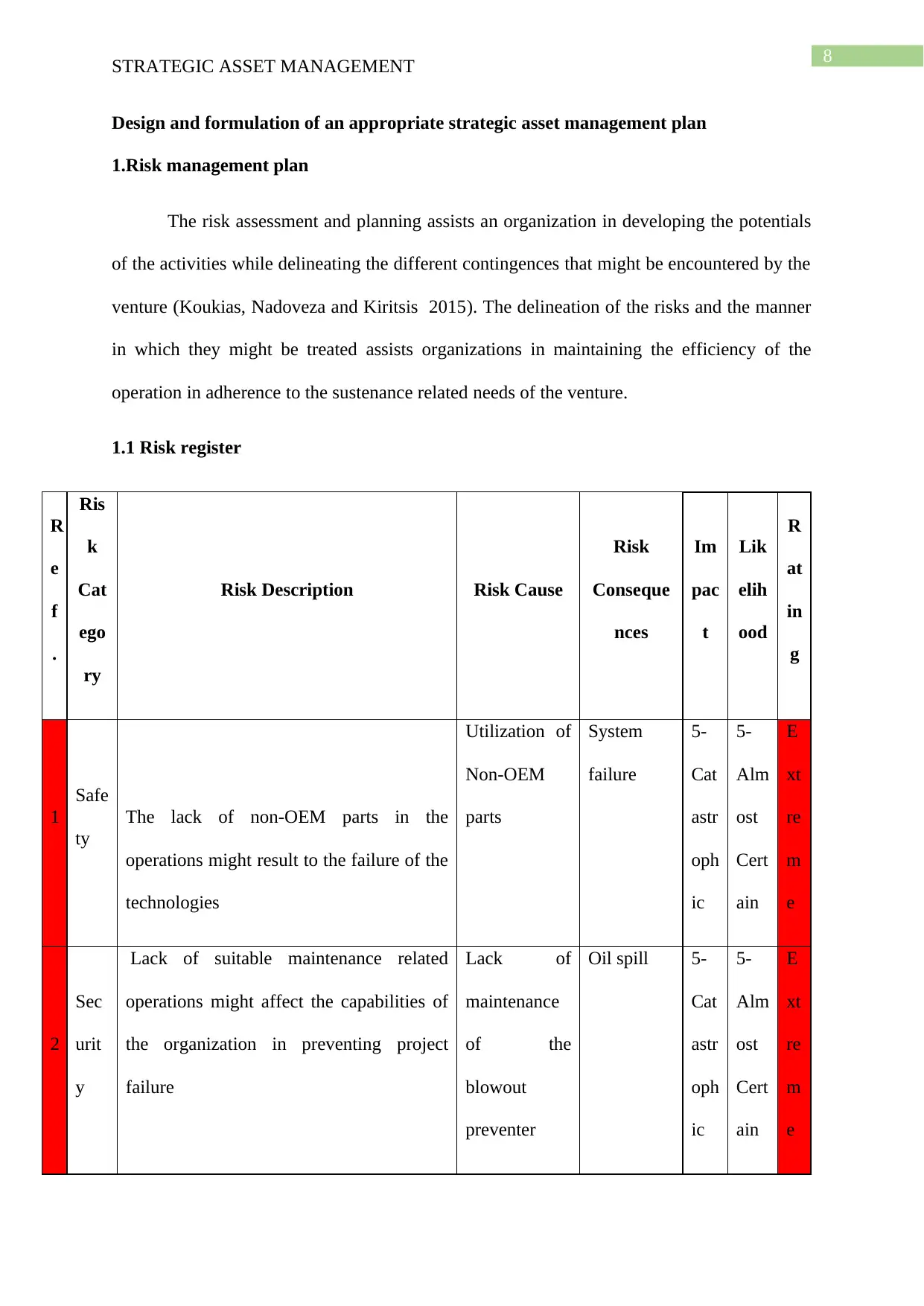
8
STRATEGIC ASSET MANAGEMENT
Design and formulation of an appropriate strategic asset management plan
1.Risk management plan
The risk assessment and planning assists an organization in developing the potentials
of the activities while delineating the different contingences that might be encountered by the
venture (Koukias, Nadoveza and Kiritsis 2015). The delineation of the risks and the manner
in which they might be treated assists organizations in maintaining the efficiency of the
operation in adherence to the sustenance related needs of the venture.
1.1 Risk register
R
e
f
.
Ris
k
Cat
ego
ry
Risk Description Risk Cause
Risk
Conseque
nces
Im
pac
t
Lik
elih
ood
R
at
in
g
1
Safe
ty
The lack of non-OEM parts in the
operations might result to the failure of the
technologies
Utilization of
Non-OEM
parts
System
failure
5-
Cat
astr
oph
ic
5-
Alm
ost
Cert
ain
E
xt
re
m
e
2
Sec
urit
y
Lack of suitable maintenance related
operations might affect the capabilities of
the organization in preventing project
failure
Lack of
maintenance
of the
blowout
preventer
Oil spill 5-
Cat
astr
oph
ic
5-
Alm
ost
Cert
ain
E
xt
re
m
e
STRATEGIC ASSET MANAGEMENT
Design and formulation of an appropriate strategic asset management plan
1.Risk management plan
The risk assessment and planning assists an organization in developing the potentials
of the activities while delineating the different contingences that might be encountered by the
venture (Koukias, Nadoveza and Kiritsis 2015). The delineation of the risks and the manner
in which they might be treated assists organizations in maintaining the efficiency of the
operation in adherence to the sustenance related needs of the venture.
1.1 Risk register
R
e
f
.
Ris
k
Cat
ego
ry
Risk Description Risk Cause
Risk
Conseque
nces
Im
pac
t
Lik
elih
ood
R
at
in
g
1
Safe
ty
The lack of non-OEM parts in the
operations might result to the failure of the
technologies
Utilization of
Non-OEM
parts
System
failure
5-
Cat
astr
oph
ic
5-
Alm
ost
Cert
ain
E
xt
re
m
e
2
Sec
urit
y
Lack of suitable maintenance related
operations might affect the capabilities of
the organization in preventing project
failure
Lack of
maintenance
of the
blowout
preventer
Oil spill 5-
Cat
astr
oph
ic
5-
Alm
ost
Cert
ain
E
xt
re
m
e
⊘ This is a preview!⊘
Do you want full access?
Subscribe today to unlock all pages.

Trusted by 1+ million students worldwide
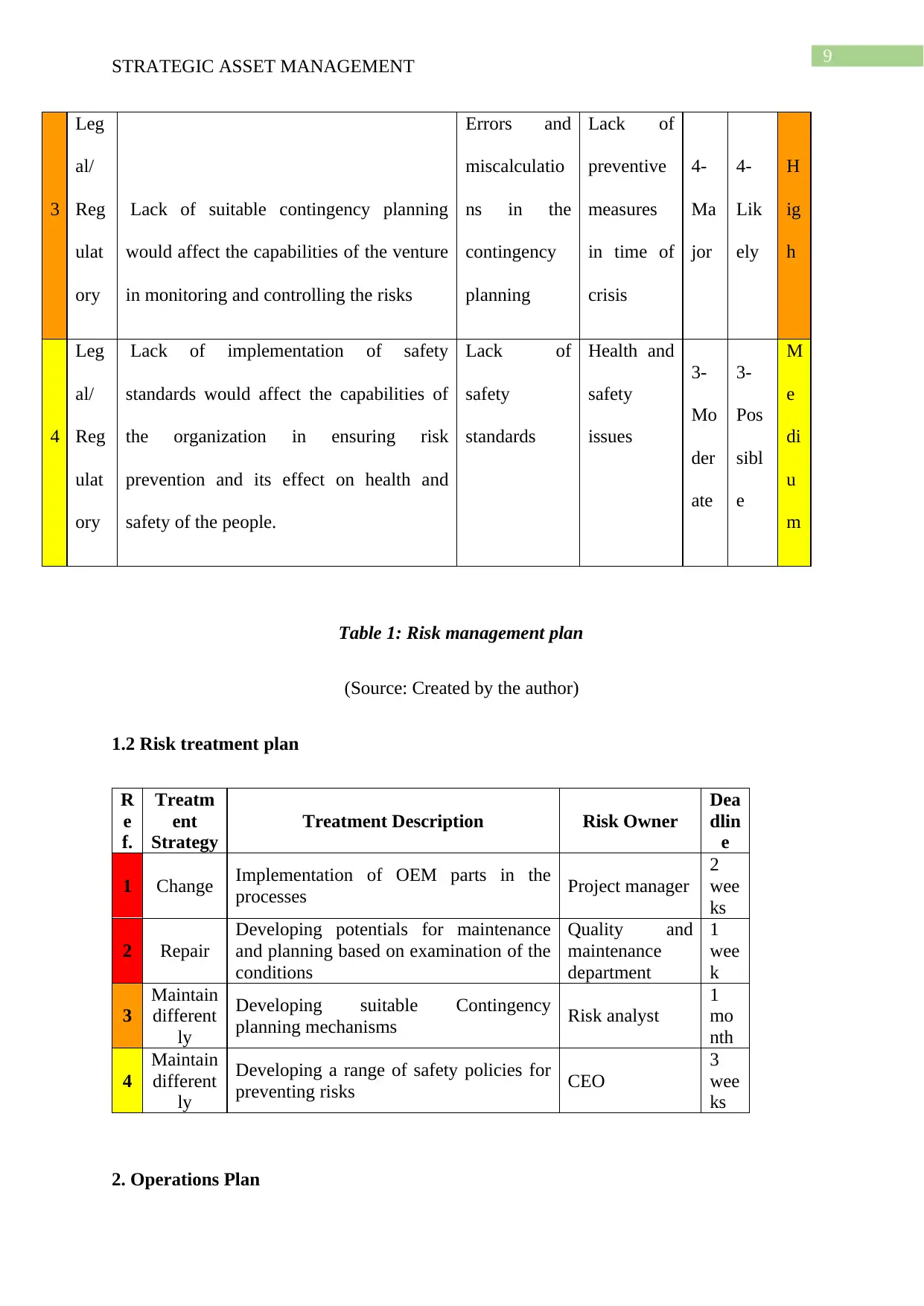
9
STRATEGIC ASSET MANAGEMENT
3
Leg
al/
Reg
ulat
ory
Lack of suitable contingency planning
would affect the capabilities of the venture
in monitoring and controlling the risks
Errors and
miscalculatio
ns in the
contingency
planning
Lack of
preventive
measures
in time of
crisis
4-
Ma
jor
4-
Lik
ely
H
ig
h
4
Leg
al/
Reg
ulat
ory
Lack of implementation of safety
standards would affect the capabilities of
the organization in ensuring risk
prevention and its effect on health and
safety of the people.
Lack of
safety
standards
Health and
safety
issues
3-
Mo
der
ate
3-
Pos
sibl
e
M
e
di
u
m
Table 1: Risk management plan
(Source: Created by the author)
1.2 Risk treatment plan
R
e
f.
Treatm
ent
Strategy
Treatment Description Risk Owner
Dea
dlin
e
1 Change Implementation of OEM parts in the
processes Project manager
2
wee
ks
2 Repair
Developing potentials for maintenance
and planning based on examination of the
conditions
Quality and
maintenance
department
1
wee
k
3
Maintain
different
ly
Developing suitable Contingency
planning mechanisms Risk analyst
1
mo
nth
4
Maintain
different
ly
Developing a range of safety policies for
preventing risks CEO
3
wee
ks
2. Operations Plan
STRATEGIC ASSET MANAGEMENT
3
Leg
al/
Reg
ulat
ory
Lack of suitable contingency planning
would affect the capabilities of the venture
in monitoring and controlling the risks
Errors and
miscalculatio
ns in the
contingency
planning
Lack of
preventive
measures
in time of
crisis
4-
Ma
jor
4-
Lik
ely
H
ig
h
4
Leg
al/
Reg
ulat
ory
Lack of implementation of safety
standards would affect the capabilities of
the organization in ensuring risk
prevention and its effect on health and
safety of the people.
Lack of
safety
standards
Health and
safety
issues
3-
Mo
der
ate
3-
Pos
sibl
e
M
e
di
u
m
Table 1: Risk management plan
(Source: Created by the author)
1.2 Risk treatment plan
R
e
f.
Treatm
ent
Strategy
Treatment Description Risk Owner
Dea
dlin
e
1 Change Implementation of OEM parts in the
processes Project manager
2
wee
ks
2 Repair
Developing potentials for maintenance
and planning based on examination of the
conditions
Quality and
maintenance
department
1
wee
k
3
Maintain
different
ly
Developing suitable Contingency
planning mechanisms Risk analyst
1
mo
nth
4
Maintain
different
ly
Developing a range of safety policies for
preventing risks CEO
3
wee
ks
2. Operations Plan
Paraphrase This Document
Need a fresh take? Get an instant paraphrase of this document with our AI Paraphraser
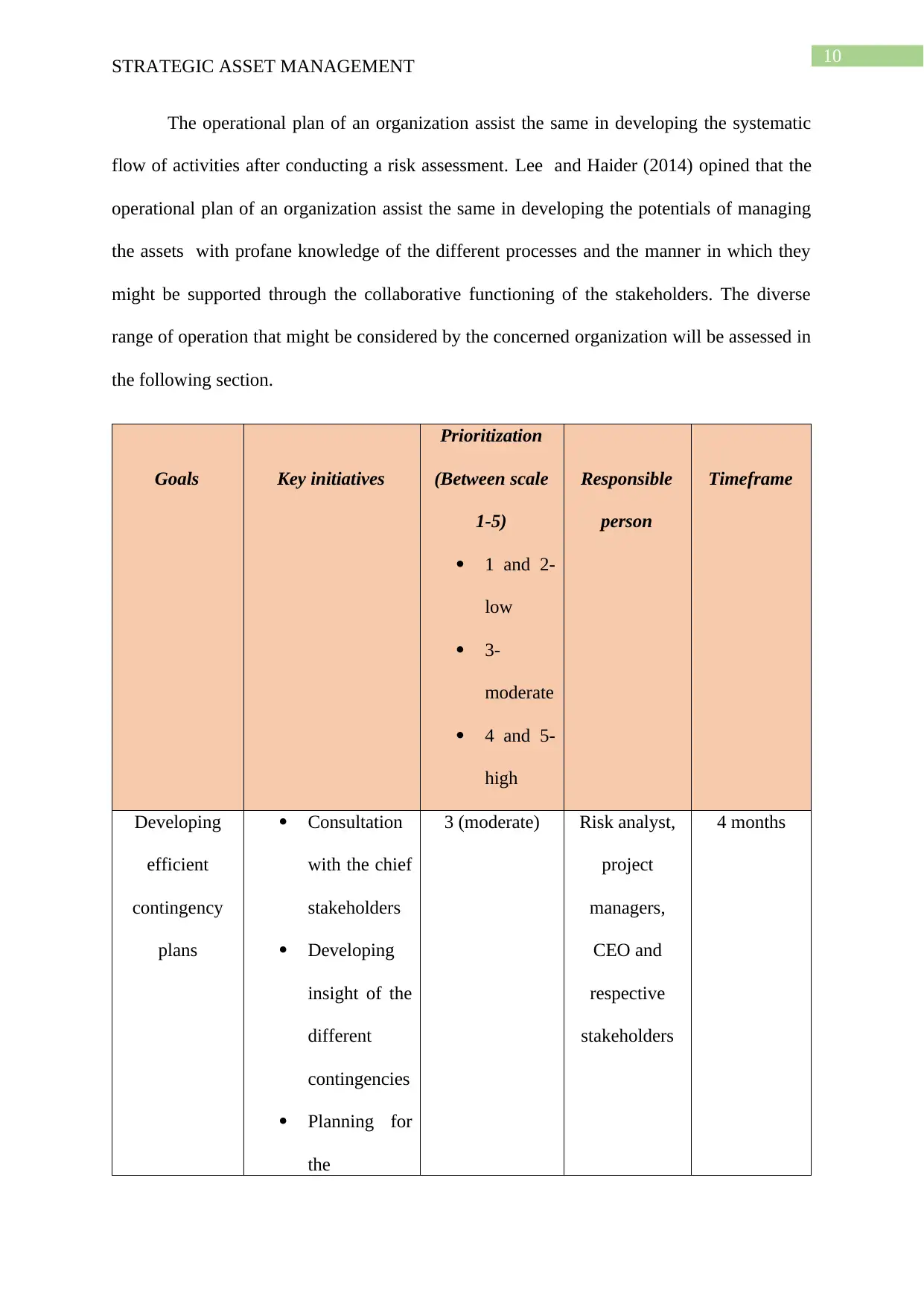
10
STRATEGIC ASSET MANAGEMENT
The operational plan of an organization assist the same in developing the systematic
flow of activities after conducting a risk assessment. Lee and Haider (2014) opined that the
operational plan of an organization assist the same in developing the potentials of managing
the assets with profane knowledge of the different processes and the manner in which they
might be supported through the collaborative functioning of the stakeholders. The diverse
range of operation that might be considered by the concerned organization will be assessed in
the following section.
Goals Key initiatives
Prioritization
(Between scale
1-5)
1 and 2-
low
3-
moderate
4 and 5-
high
Responsible
person
Timeframe
Developing
efficient
contingency
plans
Consultation
with the chief
stakeholders
Developing
insight of the
different
contingencies
Planning for
the
3 (moderate) Risk analyst,
project
managers,
CEO and
respective
stakeholders
4 months
STRATEGIC ASSET MANAGEMENT
The operational plan of an organization assist the same in developing the systematic
flow of activities after conducting a risk assessment. Lee and Haider (2014) opined that the
operational plan of an organization assist the same in developing the potentials of managing
the assets with profane knowledge of the different processes and the manner in which they
might be supported through the collaborative functioning of the stakeholders. The diverse
range of operation that might be considered by the concerned organization will be assessed in
the following section.
Goals Key initiatives
Prioritization
(Between scale
1-5)
1 and 2-
low
3-
moderate
4 and 5-
high
Responsible
person
Timeframe
Developing
efficient
contingency
plans
Consultation
with the chief
stakeholders
Developing
insight of the
different
contingencies
Planning for
the
3 (moderate) Risk analyst,
project
managers,
CEO and
respective
stakeholders
4 months
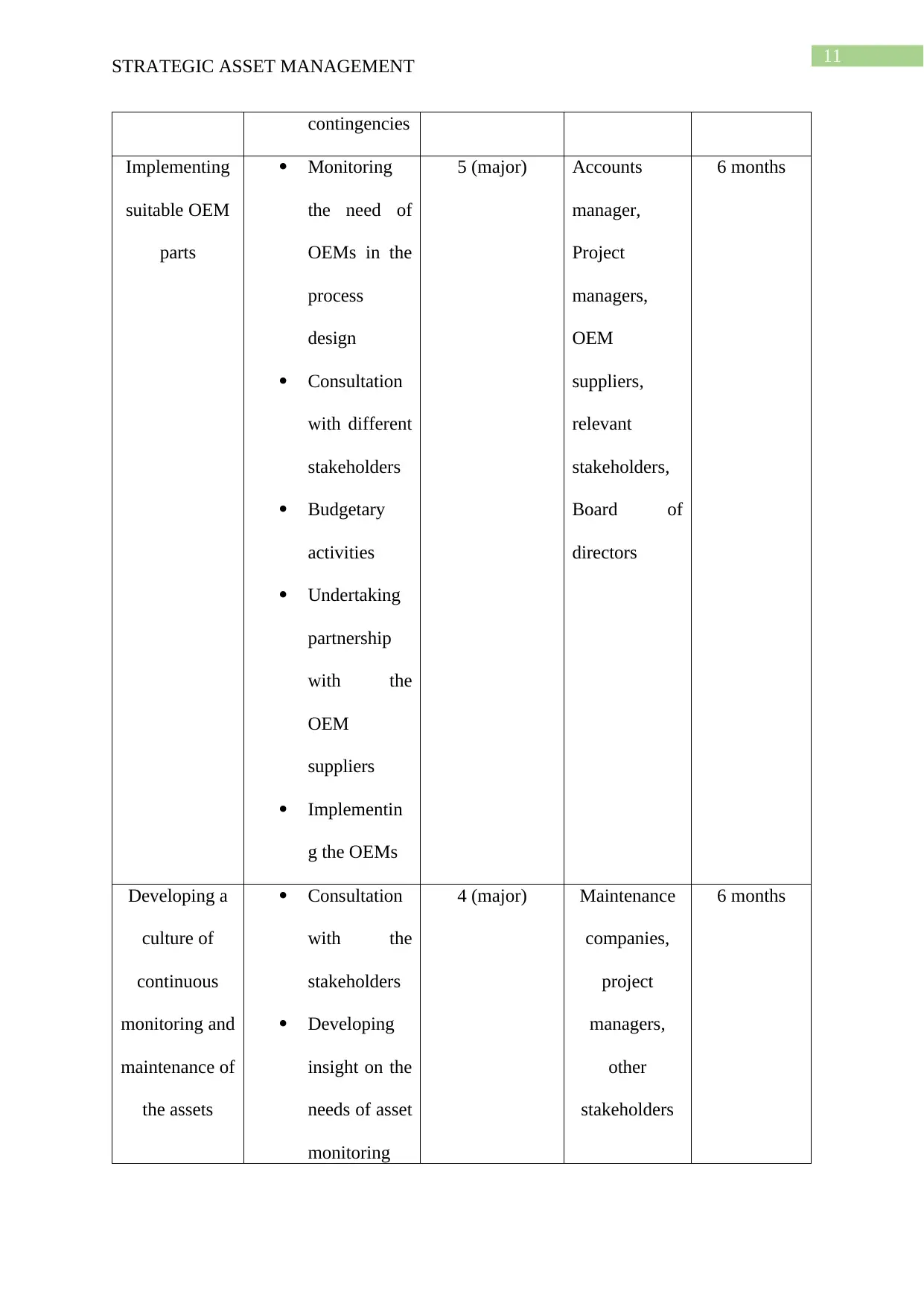
11
STRATEGIC ASSET MANAGEMENT
contingencies
Implementing
suitable OEM
parts
Monitoring
the need of
OEMs in the
process
design
Consultation
with different
stakeholders
Budgetary
activities
Undertaking
partnership
with the
OEM
suppliers
Implementin
g the OEMs
5 (major) Accounts
manager,
Project
managers,
OEM
suppliers,
relevant
stakeholders,
Board of
directors
6 months
Developing a
culture of
continuous
monitoring and
maintenance of
the assets
Consultation
with the
stakeholders
Developing
insight on the
needs of asset
monitoring
4 (major) Maintenance
companies,
project
managers,
other
stakeholders
6 months
STRATEGIC ASSET MANAGEMENT
contingencies
Implementing
suitable OEM
parts
Monitoring
the need of
OEMs in the
process
design
Consultation
with different
stakeholders
Budgetary
activities
Undertaking
partnership
with the
OEM
suppliers
Implementin
g the OEMs
5 (major) Accounts
manager,
Project
managers,
OEM
suppliers,
relevant
stakeholders,
Board of
directors
6 months
Developing a
culture of
continuous
monitoring and
maintenance of
the assets
Consultation
with the
stakeholders
Developing
insight on the
needs of asset
monitoring
4 (major) Maintenance
companies,
project
managers,
other
stakeholders
6 months
⊘ This is a preview!⊘
Do you want full access?
Subscribe today to unlock all pages.

Trusted by 1+ million students worldwide
1 out of 23
Your All-in-One AI-Powered Toolkit for Academic Success.
+13062052269
info@desklib.com
Available 24*7 on WhatsApp / Email
![[object Object]](/_next/static/media/star-bottom.7253800d.svg)
Unlock your academic potential
Copyright © 2020–2025 A2Z Services. All Rights Reserved. Developed and managed by ZUCOL.


